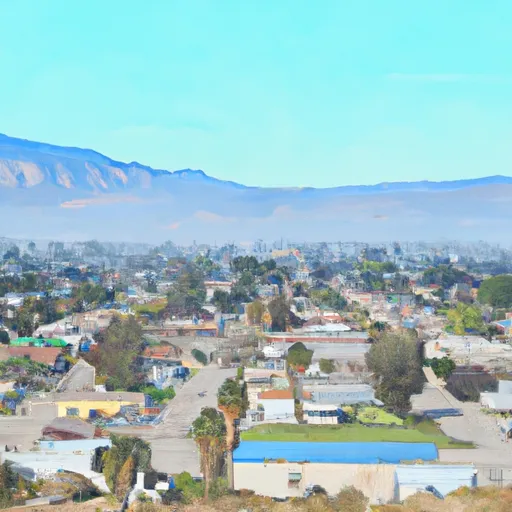-
 Snoflo Premium
Snoflo Premium
Get unlimited access to all our content
With no Ad interruptions! - Start Your Free Trial Login with existing account
New-Cuyama
Eden Index
Climate
8.6
•
Recreation
3.3
•
Community
•
Safeguard
4.6/10

New Cuyama, California is a small town located in the Cuyama Valley in Santa Barbara County. It has a semi-arid climate characterized by hot summers and mild winters. The area receives low annual precipitation and experiences frequent drought conditions. Hydrologically, the region is primarily dependent on underground water sources, as surface water is scarce. Outdoor enthusiasts can enjoy various recreational opportunities in the surrounding area. Los Padres National Forest is nearby, offering activities such as hiking, camping, and wildlife viewing. The Cuyama River also provides opportunities for fishing and picnicking. With its unique climate and accessible outdoor spaces, New Cuyama is an attractive destination for those seeking outdoor adventures.
What is the Eden Index?
The Snoflo Eden Index serves as a comprehensive rating system for regions, evaluating their desirability through a holistic assessment of climate health, outdoor recreation opportunities, and natural disaster risk, acknowledging the profound impact of these factors on livability and well-being.
Climate Health Indicator (CHI): 8.6
New-Cuyama receives approximately
230mm of rain per year,
with humidity levels near 77%
and air temperatures averaging around
15°C.
New-Cuyama has a plant hardyness factor of
8, meaning
plants and agriculture in this region tend to thrive here all year round.
By considering the ideal temperature range, reliable water supplies, clean air, and stable seasonal rain or snowpacks, the Climate Health Indicator (CHI) underscores the significance of a healthy climate as the foundation for quality living.
A healthy climate is paramount for ensuring a high quality of life and livability in a region, fostering both physical well-being and environmental harmony. This can be characterized by ideal temperatures, reliable access to water supplies, clean air, and consistent seasonal rain or snowpacks.
Weather Forecast
Streamflow Conditions
Central California Coastal
Area Rivers
Central California Coastal
Snowpack Depths
Central California Coastal
Reservoir Storage Capacity
Central California Coastal
Groundwater Levels
Recreational Opportunity Index (ROI): 3.3
The Recreational Opportunity Index (ROI) recognizes the value of outdoor recreational options, such as parks, hiking trails, camping sites, and fishing spots, while acknowledging that climate plays a pivotal role in ensuring the comfort and consistency of these experiences.
Access to outdoor recreational opportunities, encompassing activities such as parks, hiking, camping, and fishing, is crucial for overall well-being, and the climate plays a pivotal role in enabling and enhancing these experiences, ensuring that individuals can engage in nature-based activities comfortably and consistently.
Camping Areas
| Campground | Campsites | Reservations | Toilets | Showers | Elevation |
|---|---|---|---|---|---|
| Davy Brown | 13 | 2,250 ft | |||
| Los Prietos | 37 | 1,088 ft | |||
| Nira | 11 | 1,836 ft | |||
| Fremont | 15 | 981 ft | |||
| Selby | 6 | 2,420 ft | |||
| Upper Oso | 25 | 1,166 ft | |||
| Lake Cachuma | 550 | 802 ft | |||
| KCL - Carrizo Plains | 12 | 2,282 ft | |||
| Aliso Park | 10 | 2,909 ft | |||
| Bates Canyon | 6 | 2,778 ft |
Nearby Fishing
Catastrophe Safeguard Index (CSI):
The Catastrophe Safeguard Index (CSI) recognizes that natural disaster risk, encompassing floods, fires, hurricanes, and tornadoes, can drastically affect safety and the overall appeal of an area.
The level of natural disaster risk in a region significantly affects safety and the overall livability, with climate change amplifying these risks by potentially increasing the frequency and intensity of events like floods, fires, hurricanes, and tornadoes, thereby posing substantial challenges to community resilience and well-being.
Community Resilience Indicator (CRI):
The Community Resilience Indicator (CRI) recognizes that education, healthcare, and socioeconomics are crucial to the well-being of a region. The CRI acknowledges the profound impact of these elements on residents' overall quality of life. By evaluating educational resources, healthcare accessibility, and economic inclusivity, the index captures the essential aspects that contribute to a thriving community, fostering resident satisfaction, equity, and social cohesion.

